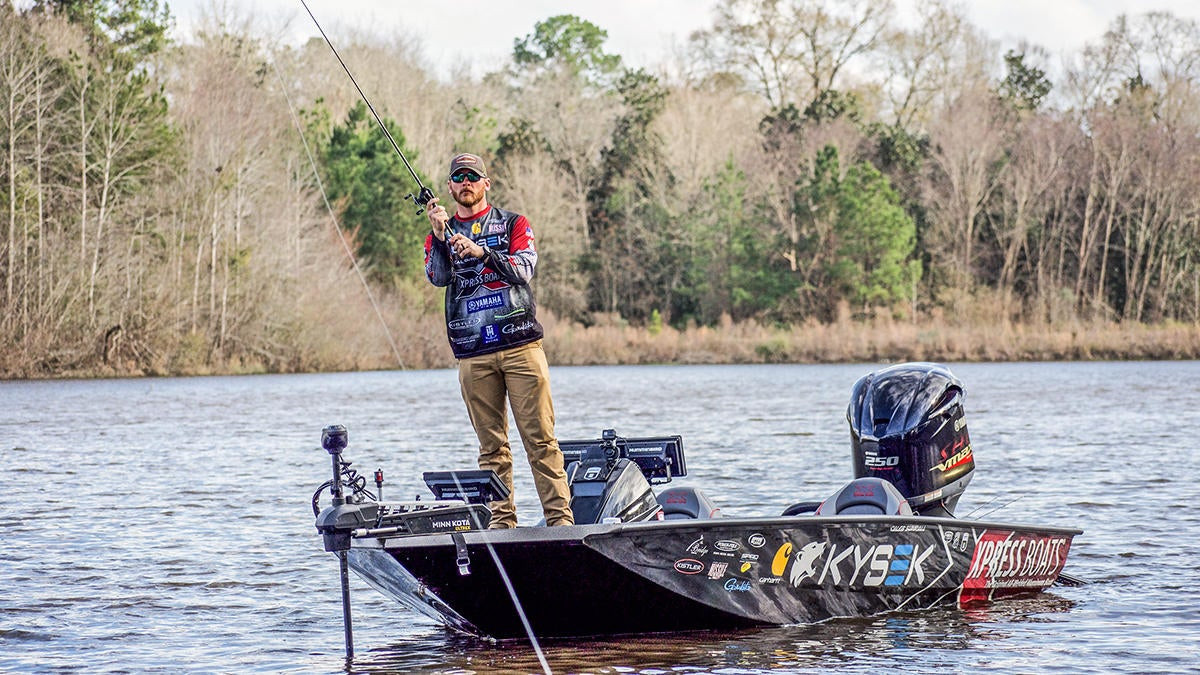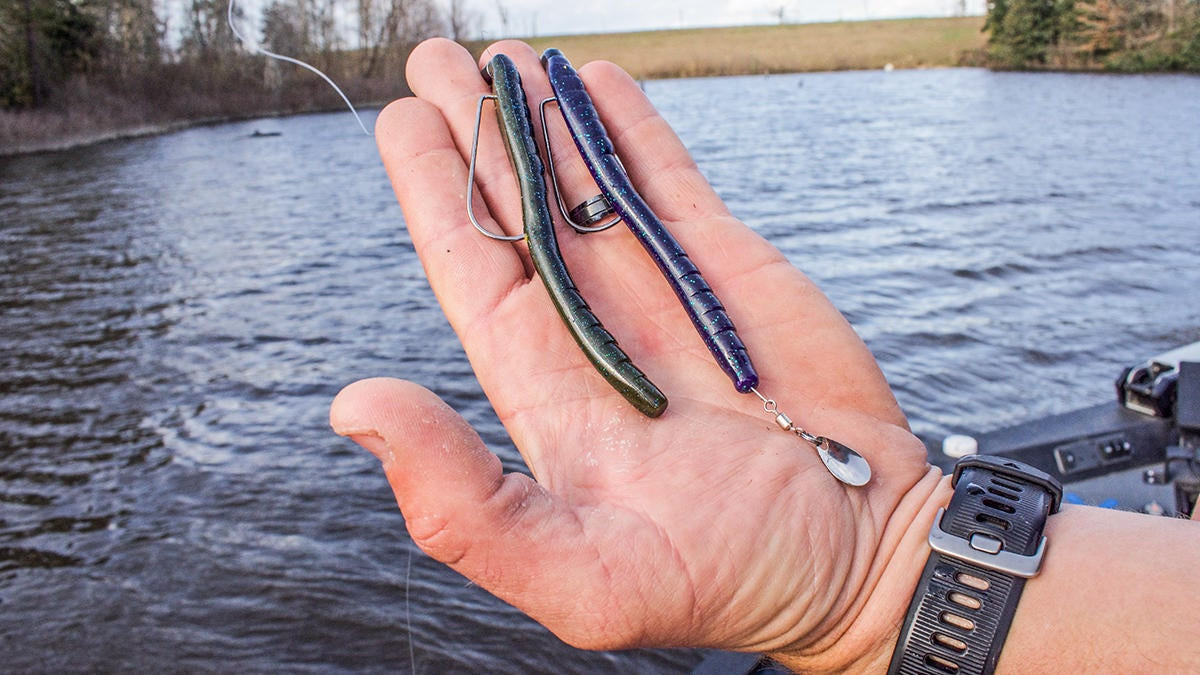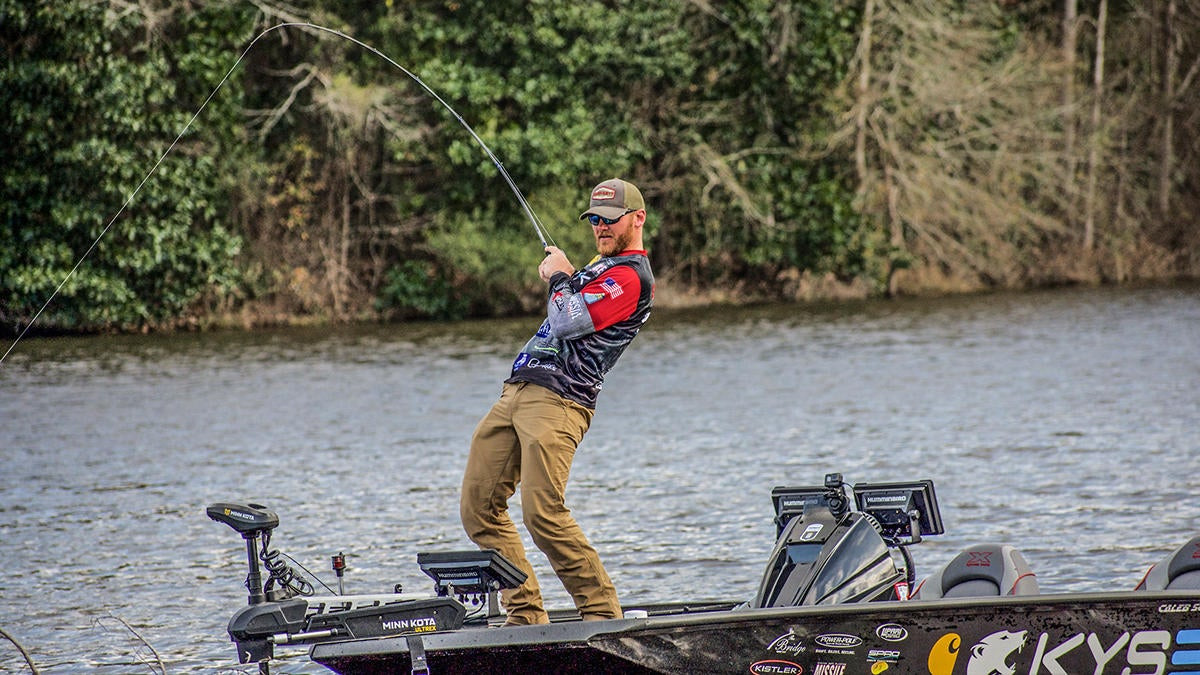There are few lures that catch more bass in the springtime than simple stick worms. Something about the shape and action of them drives bass crazy. You can Texas rig them, wacky rig them, fish them on a Neko rig, add them to the back of a Carolina Rig and the list goes on from there. Simply stated, stick worms’ versatility and performance has been proven time and again.
Professional angler Caleb Sumrall employs all these rigs depending on the conditions, but his hands-down favorite way to fish a stick worm is to add a screw lock-style spinner blade like a Humdinger Keith Poche Power Spinner to the back of his worm. Sumrall catches bass from Texas to New York with this setup and believes it’ll help you get more bites, too.

Why add a spinner to your stick worm?
Sumrall grew up learning to fish in the shallow, stained waters of Louisiana. When he saw Keith Poche add a Humdinger Power Spinner to his stick worm during the 2012 Bassmaster Classic on the Red River, he immediately liked what he saw and added the presentation to his Xpress bass boat’s arsenal.
“It’s just something fish aren’t used to seeing,” Sumrall said. “Bass these days are educated, so I try to do anything I can to set my bait apart from what other anglers are using. Adding a screw-lock spinner to your stick worm adds a subtle flash to an already proven fish-catching soft plastic. They seriously can’t stand it.”
While Sumrall believes this setup is at its best when the water has some color to it, he won’t shy away from giving the stick worm spinner a try in gin-clear water. Noting that the extra flash put off by the screw-lock spinner triggers aggressive fish into biting no matter the water clarity.
The only time Sumrall decides against adding a spinner to his soft plastic is post-frontal conditions when bass are acting extra finicky. In this scenario, he’ll opt for a more finesse presentation with his stick worms like a weightless wacky rig or Texas rig.

Sumrall’s setup
Any brand of Senko-style or finesse worm pairs perfectly with a screw-lock spinner, but Sumrall’s favorite is a Missille Baits The 48 Worm. Sumrall rigs The 48 Worm on a 5/0 Gamakatsu Offset Round Bend Worm Hook with a 3/16- to 1/4-ounce tungsten sinker and fishes this setup on 16- to 20-pound Sunline Shooter Fluorocarbon.
“Even on windy days I won’t go heavier than a 1/4-ounce weight with this presentation,” Sumrall said. “The spinner blade adds resistance, vibration and slows the fall of your stick worm. Adding too heavy of weight overpowers this action and cancels out what you’re trying to do. On the flip side, I use as big of a hook as possible because fish have a tendency to nip at the back of your worm when you add a spinner. The bigger the hook, the better your chances at getting a solid hookup.”
Just like with spinnerbait blades, screw-lock spinners come in a plethora of options. Sumrall most often relies on a No. 3 Gold Colorado blade from Humdinger, but says willow blades or colored blades all have their time and place, too.
“You can think of the specific blade sizes and colors just like a spinnerbait,” Sumrall explained. “I alter between a willow and Colorado blade based on the water clarity and amount of vegetation I’m fishing around. I’m constantly experimenting with different colors and sizes. Typically, the clearer the water the more I’ll use a willow blade. If the water has some stain to it and I want more vibration, I’ll opt for a Colorado blade.”

Three ways to fish ’em
Another added bonus this rig is its versatility in how you retrieve it. Sumrall has found the most success with three retrieves that all offer bass a slightly different look while using the same exact lure.
Flip it: “My favorite way to fish this setup is to flip it and drag it just like a regular Texas-rigged soft plastic,” Sumrall said. “Not many guys use it this way, but slowly dragging your worm on the bottom with the spinner lightly thumping along drives bass crazy. I’ll pitch it into bushes or drag it through grass, basically fish it anywhere I’d employ a traditional Texas-rigged worm. The spinner sets your worm apart ever so slightly and I believe results in a few more bites.”
Swim it: Swimming a stick worm with a screw-lock spinner is how Keith Poche made this rig famous back in 2012. Simply cast your worm out, keep your rod tip high and slowly reel it in. Following the same methodology as a classic swimming worm, but with flash and a different vibration than an aggressive thumping paddle tail. The faint thump on the back of a subtle stick worm is something bass aren’t used to.
You can swim this setup anywhere, but it’s best when covering shallow flats, over aquatic vegetation or even over top of spawning beds. Think of it as a way to power fish with a finesse twist.
Yo-yo it: If Sumrall can’t get bass to commit to the worm while swimming it and dragging the rig isn’t covering enough water, he will try to meet the bass in the middle by imparting a stop-and-go retrieve.
“The third way I fish this outfit is to yo-yo it almost like I’m fishing a lipless crankbait,” Sumrall said. “When bass don’t want to eat to the worm on a steady retrieve, try dropping the bait to the bottom every 15 feet or so. More or less combining the first two retrieve methods for the best of both worlds. Whether you are covering a flat or dropping the worm into holes in a grass mat this can be extremely effective.”
As bass head to shallow water in your area be sure to pick up a few packs of screw-lock spinner blades to add a little flash to your favorite stick worms. Include this presentation with the plethora of other ways you can fish these subtle soft plastics and catch more bass this spring.












